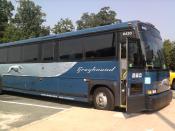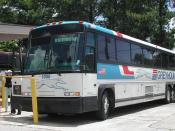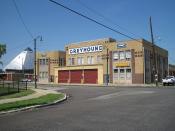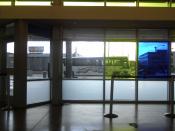1) What were the critical incidents in Greyhound's growth and development over time? Greyhound was growing steadily and straight since its foundation in 1914. Their original business was bus transportation. By 1960 they covered nearly all of North America with its bus transportation and were gaining so much profit that they were looking for new opportunities to invest. The decision was made to diversify. This resulted in a conglomerate of three different major businesses in the end of 1963: bus transportation, bus manufacturing, and financial services. Gerry Trautman was appointed CEO in 1966. He kept on diversifying and expanding Greyhound.
But with this expansion and diversification strategy Greyhound was not always right. Between 1970 and the mid-90's there were several critical incidents which had important influences on Greyhound's growth and development. Trautman tried to diversify into many related and unrelated businesses to gain from synergies and make Greyhound more recession-proof.
After acquiring many transport related businesses, he purchased Armor & Co. in 1970 (his biggest acquisition), sold of several divisions, and what remained was the profitable Dial division and Armor's food division. Greyhound moved into a business where they had no experience. In the 70's several acquisitions proved to be unprofitable, but in 1978 Trautman bought the Verex Corporation a big private insurer. Now Greyhound structure had changed; they had now five major business: services/food services and food and consumer products were added. But the first serious problems became apparent in 1980, when Armor's food division dropped from a profit of $22 million in the last year to a loss of $1.7 billion. With making Teets CEO of the food service group, Armor soon ran more efficient. In 1981 Teets became the new CEO of Greyhound. Greyhound's food division remained a weak competitor, so Teets sold it in 1983. This had been another major incident, as well as a new deregulated bus transportation market, which caused hard competition. Because of Inertia and not being efficient (because of being kinda Monopolist in this business), Greyhound paid more wages (30-50% more than their competitors). In 1987 Greyhound sold its bus lines and even tried to sell most of its financial businesses. From now on Teets concentrated more and more on the consumer products division; he bought Purex (1985) and some others. The next important incident was that the sold Greyhound Bus Lines company declared bankruptcy. In order to distance from that Teets changed the company's name to Greyhound Dial (GD), which also marked the company's new focus on the consumer products division. But after reporting a loss of the Dial's division, GD's stock price plunged. Nevertheless Teets kept on acquiring, and bought Breck. To stress the future focus even more they changed the company's name in 1991 to Dial Corp. Then Dial sold its financial services division completely. After this restructuring Dial was better off and things developed well for Dial. But within a short period in the mid-90's serious problems affected Dial throughout most of its businesses. The transportation manufacturing performed badly, so Teets disposed of it. But Purex was doing poorly, too, and Teets cut the advertising budget to 60%, which made Dial loose market share (more than 2%). Teets phased out the Purex bleach line and some later the former successful Lunch Buckets. At the same time Disney decided to launch its own cruise line and didn't want to prolong the contract with Dial's cruise lines for Disney theme cruises. As a result Dial withdrew from the cruise-ship business. Even the food services faced problems, because the biggest part of the sales was made by serving airlines and airport restaurants. But airports allowed fast-food chains to move in and the airlines had to cut costs and began to offer snacks or nothing instead of full meals. This hurt Dial's catering business badly. The last incidence was the break up of Dial Corp. in 1996 into two individual businesses. Dial Corp. went on operating in consumer products, while the new one, Viad Corp., would manage all the remaining businesses (some financial, exhibition and catering businesses). Teets retired in 1997. And Dial's new strategy was to focus on consumer products and to strengthen the company's portfolio.
2) What was the underlying corporate strategy behind development of Greyhound's portfolio of investments up until the time that Teets was appointed CEO? Was Trautman correct to pursue this strategy? What were its advantages and pitfalls? The main strategy was to diversify Greyhound's businesses. In the past Greyhound accelerated enormous profits, so the company wanted to diversify its business into other areas, and expanded into the bus manufacturing business and others. Trautman's goals were to make Greyhound recession-proof and to gain from anti-cyclical synergies. But furthermore he tried not only to make the company recession-proof, but even every individual division. So he achieved diversification within diversification. In 1978, Greyhoundôs holding company consisted of five operating divisions: transportation, bus manufacturing, food and consumer products, financial, and services/ food service. Trautmann felt that he was shaping a diversified company that would have a powerful base in many lines of business. He was willing to take the risk of acquiring some companies that would be failures as long as the overall health of the company was strengthened.
I think it's important to diversify, but maybe it's better to diversify into related businesses, where you can profit from you managerial experience and know-how. Diversification has always advantages. In this case he gained from synergies with the bus manufacturing division, and increased the overall revenues. But the strategy had also disadvantages, which were fatal in the Greyhound case. I think he lost the overview and diversified in several unrelated business, where he could not gain from synergies and managerial experience and knowledge lacked. He should have stick to the transportation business, the bus manufacturing, and, maybe, financial services, which have to do with both businesses (e.g. leasing, financing, insurance of buses etc.). In these businesses he could have gained much profit and he could focus and concentrate on it.
3) What environmental factors affected Greyhound's business? Could anything have been done to control for environmental factors? In what ways did they distort the picture of Greyhound's performance? Some environmental factors influenced Greyhound's performance and the whole business. The first factors mentioned in the text were the recession and energy crunch in 1979-1980 and high interest rates in the early 1980s. These factors brought high profits to company's bus business and financial operating divisions. Another factor was the change in consumer taste that changed the demand of several products Greyhound offered. In 1982, the bus transportation market was deregulated, and Greyhound got serious problems with competitors, because Greyhound missed to monitor the environment. While being some kind of monopolist in this market for several decades, the company did not care about efficiency, customer response, quality and innovation. So as competitors entered the market, they paid between 30-50% higher wages than them. They lost market share and finally sold the bus line in 1987. The oil bust in the early 1980s brought a recession in the real estate market. Verex (real estate firm Greyhound acquired) suffered huge losses generated by insurance claims. A few years later, airlines cut their cost; with this they did not serve full meals anymore, but instead just snacks or nothing. Furthermore the airports allowed fast food chains to move in to diversify the airports' supply to the customers. This incidence hurt Greyhound's food service business.
Most times you are not able to control the environment, because you can't influence it directly. But you can be aware of changes, and you should always monitor it carefully. Sometimes you can foresee some incidents or developments. The next thing is that you should always move on, develop further, and don't stand still even if times are good. Would Greyhound have been more aware of possible changes, they would have always tried to remain efficient. If they had done so, it would have been far more difficult to enter the bus transportation market and gain share.
4) What did Teets do to change Greyhound's corporate strategy and financial position in the 1980's? Analyze the rationale behind this strategy. Was it working? Teets tried to restructure the company. He sold the weak performing Armor Food Company and the bus line, because Greyhound was not able to compete with a new market environment. Even in the financial service group he sold several companies and tried to downsize the conglomerate's businesses. Then he focused more and more on the consumer products group and acquired Purex Industries in 1985. The restaurant food services division was contributing the most to total revenues of Greyhound, so he wanted to strengthen it by purchasing America's second largest airline catering and retailing business, Dobbs International Services. Furthermore he tried to strengthen the financial services group with purchasing Republic Money Orders, Inc., and returned to the cruise ship business with buying Premier Cruise Lines and making a contract with Disney for theme cruises.
The rationale was to strengthen the main businesses by acquiring better fitting companies and divest bad performing ones. He wanted to focus more instead of diversify as much as before. Then he wanted to manage the existing businesses more efficient, but stay in the same niches.
At first this strategy seemed to work, but as competition became harder in and the economical situation changed in the 90's, the strategy proved to be not working at all. This caused much trouble and ended up in a split of the company in 1996 and the retirement of Teets in 1997.
5) How has Teets' strategy worked in the 1990's? In the beginning of the 90's Teets' strategy seemed to work. Because of many spun offs of the loss-making businesses and a focus on a more narrow business line, the stock price rose of almost 150% from 1990 to 1992. Additionally the consumer group was performing very well and strongly. And Teets did not only downsize the amount of businesses, but also the amount of managers of one fourth. Even analysts had some hope that this would indicate a turnaround. But they were wrong.
The economic situation changed rapidly and affected nearly every of Greyhound's businesses. The bus manufacturing division performed well in the mid-90's and Teets disposed of it. The Purex bleach line also performed badly, so it has been phased out. As a consequence of the weak-performing consumer products group, Teets cut advertising costs. But this caused a lost of shares of more than 2%, because with weak marketing you can't compete with strong competitors like P&G. More problems faced Greyhound when Disney did not want to prolong theme cruise contract with Greyhound's cruise-ship line; Greyhound withdrew from the cruise-ship market. As mentioned above the airlines cut costs and had a bad impact on Greyhound's food service division. It seemed to be no more than a hodgepodge of different businesses. To create new value of existing businesses, Greyhound should be split into two individual companies in 1996. So you can say that Teets failed.
6) Do you think that Dial should be split into two companies or that its assets should be divested? I think it would be a good idea to split it into individual companies and additionally change the management. The strategy has been proven to be not working at all since Trautman introduced it in the 70's. Greyhound always suffered on any problems. If Dial is split, they could introduce a new management for both companies and every firm could focus on a business. It would probably be much easier to restructure a company and develop a new strategy, if you can concentrate on one business. Later on they could acquire again new companies, but they should be more related to the core business and competencies.
Dial was split in 1996 and Teets retired in 1997. Teets found his own company and operates a real estates business. And if you can see on their homepage, Dial is now performing better.



